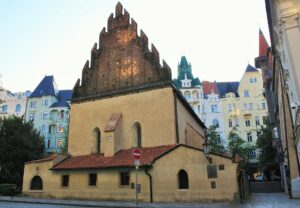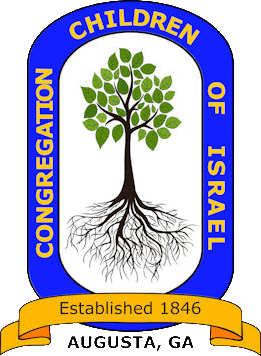Westminister Holocaust Scroll / Memorial Scrolls Trust No. 644
In 1976 Rabbi Richard White of Congregation Children of Israel contacted the Union of Liberal & Progressive Synagogues in London, England for more information regarding Torah scroll known as Memorial Scrolls Trust #644.
This scroll was traced to the Alt-Nueue Shul in Prague, Czechoslovakia. Later investigation suggested that the scroll may have been in the possession of Rabbi Yeshaya Weiner of Prague (c.1726-1798) or his family. Rabbi Weiner is noted as the author of the book “Bigdei Yesha”, a major commentary on the first section of the Shulchan Aruch. We believe it is very possible this scroll belonged to him or his family. The Jewish Museum in Prague was created in 1906 and at the time the Nazis occupied Czechoslovakia the collection contained some 760 items. Although the German authorities immediately began to enforce racial anti-Jewish laws the day the Protectorate was established, the Jewish Museum in Prague continued to exist. In September 1941, the Nazis banned the holding of Jewish services and in December 1941 it became a storehouse for items taken from the empty Prague synagogues.
Following instructions from the Nazi Zentralstelle in 1942 for all communities in Bohema and Moravia to send their “historically valuable” items to the Jewish Museum in Prague, some members of Prague’s Jewish community persuaded the Nazis to allow them bring other religious treasures from the deserted communities and destroyed synagogues to the comparative safety of Prague. More than 212,000 artefacts were brought to the Museum. Among them were about 1,800 Torah scrolls. Each item was meticulously recorded. labelled and entered on a card index by the Museum’s staff with a description and the place it had come from. The Nazis’ interest in the museum most probably developed from a number of practical problems that had to be resolved. The main reason is clear – the museum enabled the Nazis to gain in a short period of time in-depth knowledge about confiscated Jewish objects that were of particular value. It is clear that the Nazis had no experts for such specialist work as the registration and evaluation of confiscated Jewish artefacts that were of artistic or historical value. It is possible that the Nazis saw the museum as a special department for the collection, documentation, storage and evaluation of confiscated Jewish property. The scroll known as MST#644 was catalogued by the Jewish curators in Prague during the war with number 5 of what would become over 210.000 items of Judaica that survived the Shoah, is one of only 4 scrolls from the Alt-Nueue Shul in Prague, that goes back to the 13th century.

ALT-NEU Synagogue, Prague, Czechoslovakia
Following the reciept of Memorial Scrolls Trust #644 a Dedication Service was conducted by Rabbi White at Congregation Children of Israel on April 27, 1973. The scroll resides in the Ark in the Sanctuary at CCI and has been under the care of all CCI rabbis since Rabbi White.
In June 2016 Congregation Children of Israel Rabbi Robert Klensin undertook an effort to perform cosmetic repair and maintenance on the scroll. He contracted with Sofer On Site International of Miami, FL to perform the curative work at a cost of almost $3,000.
About the Scroll
Sofer On Site International provided the following assessment in June 2016;
The scroll was written approximately 250 years ago. We have reason to believe it comes from Prague; it was written on a good Beit Yosef- Czech script and it’s a medium-light weight scroll. One interesting fact to point out is the signature found both at the beginning and the end of the Torah, which reads בן’ ישעי הקטן small the or (insignificant the ” translated roughly”, הנעלה כהר”ר שמחה ווינר יצ”ו” one) Yeshaya the son of the exalted and honorable Rabbi Simcha Weiner may our Rock (G-d) protect him guard him and grant him life”. This refers to the famed Rabbi Yeshaya Weiner of Prague (c.1726-1798), author of the book “Bigdei Yesha”, a major commentary on the first section of the Shulchan Aruch. We believe it is very possible this scroll belonged to him or his family. This means that our estimation on the age of the scroll is very accurate and concurs with the time that Rabbi Weiner lived in Prague. If this is so, then it is a very exciting find and could be a great prospect for a restoration project. There are various areas of letters that are fading from dark red brown to brown and often to light brown. There are several areas as well where the letters are simply cracking and peeling off the parchment. In addition there are many areas with letters that are in the initial stages of deterioration, which will more likely become a problem in the future. The scroll needs general cleaning; each book will need at least one hour. We also found sections where the sewing is weak and is starting to tear, as well as several seams with torn parchment that will need patching. From the end of Shemot and towards the second parsha of Vayikra there are some stains related to water damage, and although the letters are still clear they may need some touch-ups to make sure they don’t fade out soon.
Further restorative work remains to be done. Sofer On Site International provided the following assessment;
There are various areas of letters that are fading from dark red brown to brown and often to light brown. There are several areas as well where the letters are simply cracking and peeling off the parchment. In addition there are many areas with letters that are in the initial stages of deterioration, which will more
likely become a problem in the future. The scroll needs general cleaning; each book will need at least one hour. We also found sections where the sewing is weak and is starting to tear, as well as several seams with torn parchment that will need patching. From the end of Shemot and towards the second parsha of Vayikra there are some stains related to water damage, and although the letters are still clear they may need some touch-ups to make sure they don’t fade out soon. We would welcome monetary contributions to allow us to continue the conservation of this historic scroll.

